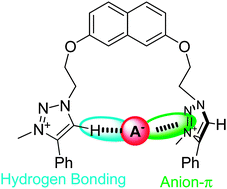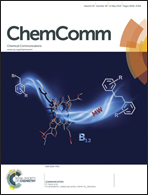Discovery of anion–π interactions in the recognition mechanism of inorganic anions by 1,2,3-triazolium rings†
Abstract
A bis(triazolium)-based receptor designed for anion recognition is presented. NMR spectroscopic data indicate that one triazolium ring is acting as a hydrogen bond donor, whereas the second triazolium ring behaves as an anion–π receptor. The simultaneous presence of two noncovalent interactions allows us to achieve a highly selective binding of the hydrogenpyrophosphate anion.


 Please wait while we load your content...
Please wait while we load your content...